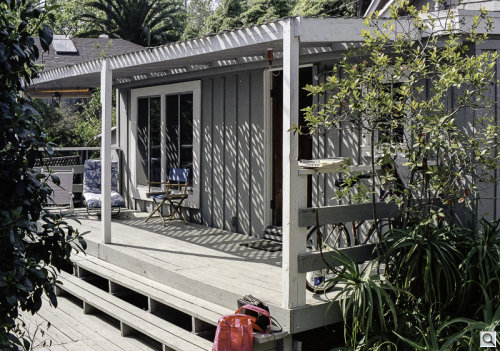Photo Corners headlinesarchivemikepasini.com
![]()
A S C R A P B O O K O F S O L U T I O N S F O R T H E P H O T O G R A P H E R
![]()
Enhancing the enjoyment of taking pictures with news that matters, features that entertain and images that delight. Published frequently.
Friday Slide Show: Montecito




12 January 2018
Our connection to Santa Barbara goes back a few decades. We attended the University of California at Santa Barbara for our freshman and sophomore years, becoming city editor of the Nexus, the student paper.
Two of our brothers attended UCSB as well but they stayed, raising their families there. Our youngest brother lived in Montecito before he married and moved to the other side of the golf course.
We visited him a few times over the years, sharing Thanksgiving and Easter holidays. He lived in a couple of the historic buildings in the old Spanish Town section of Montecito.
That compound then consisted of the Alameda Saloon, a grocery store and "a building whose original use is unconfirmed," according to the more reliable reports. It was either/or/and a barn, a dance hall, a blacksmithery, a boarding house and a bordello.

Spanish Town. Circled with the Alameda Saloon in the top left, the General Store to the right and the Bordello below.
He lived in the grocery store at first and then moved to the saloon. The property is on a 90-degree curve of East Valley Road, which is just a two-lane road running through the town. On the other side of the road is Montecito Creek where we'd hear frogs singing all night.
Across East Valley Road was, in the 19th century, La Parra Grande or giant grapevine, a pergola that was an early tourist attraction. Michael Redmon described it:
Members of the Dominguez family had planted this huge grapevine sometime in the 1780s. By the mid 1870s, the trunk of the vine measured more than 40 inches in circumference and its branches spread out over 5,000 square feet. At its most prolific, it yielded around 20,000 pounds of grapes annually.
At the end of its life, it was cut into sections and shipped to Philadelphia to help celebrate the nations' centennial.
And down the road was Our Lady of Mount Carmel, a Catholic church and grammar school which is on the site originally considered by Junipero Serra for Mission Santa Barbara.
The compound, now owned by the Montecito Fire Dept., featured an unusual attraction. We'll let Peter Hartmann and Stacey Wright describe it:
In that part of Spanishtown, a gravestone marks the resting place of Margarita McGary, the daughter of Viviana Sanchez and her husband Pedro Romero, however it's not certain that Margarita is in fact buried in that spot. There is much local lore regarding the lives and deaths of the residents of Spanishtown and Margarita's is among those whose history is uncertain.
The outlaw Joaquin Murieta, the Mexican Robin Hood, was rumored to have hidden out at the compound, in at least two of the buildings.
But you didn't need a rumor to know that across the street from the compound the Chumash elder Sky Eagle, aka Victor Lopez, lived. There aren't many references to him online but we were charmed by this one by Michael Fressier, Jr.:
Do you believe that while Victor (Sky Eagle) Lopez was conducting the site-blessing ceremonies there at the entrance to Stearns Wharf, as he held to his lips the abalone shell containing the smoldering purple sage and blew the smoke to the north and east, the south and west, that there in the Santa Barbara noonday sun, with no clouds in the sky and with the air as ocean-scrubbed clean as on the day of creation, so clear that Santa Cruz Island looked close enough to touch , that as Victor Lopez was invoking "Father Sun and Mother Moon" and asking that all animals be blessed, "the ant to the elephant," and as he called upon the gods of Chumash Indian ancestors, the Stone Age oceangoing people who had held this turf for 10,000 years and exist now only as small clay figures tending tiny painted fires up at the Natural History Museum, that as he called upon all of that while bicyclists, skateboarders and runners cruised by and tourists smiled, that at just that moment, a few hundred yards off the beach, pods of good-time dolphins were popping their shiny smiling beaks out of the water.
Our photos of the place from about 30 years ago don't do justice to its charm. The sun filtering through the avocado trees, the creek gurgling, the old floors, the sign above the bar, the window panes and that graveyard by the bordello to remind you how short life is.
We've been checking in with our youngest brother, who then ran his own graphic arts studio from the Alameda Saloon. There's been no word on the fate of Lotusland or the compound. But Parra Grande Lane was hit hard and that mud had nowhere to go but through the compound. Margarita's grave may not, after all, have been her final resting place.
But for a moment we thought we'd honor them the way they were for what they had been. In the end, that's all one can ever do.
Comments
I didn't know you had a connection to Santa Barbara and I've been reading Photo Corners for a while too! Lotusland was spared.
Unfortunately, I think Montecito won't ever be the same again.
-- Andre Yew
Ah, thanks for that bit of good news about Lotusland, Andre. (The Facebook link is a note from CEO Gwen Stauffer that "Lotusland is fine" and had avoided flooding if not a lot of debris.)
You're no doubt right about Montecito in general, though. That's what prompted today's show. Even though the images are not great, they preserve a little of that marvelous history.
-- Mike
